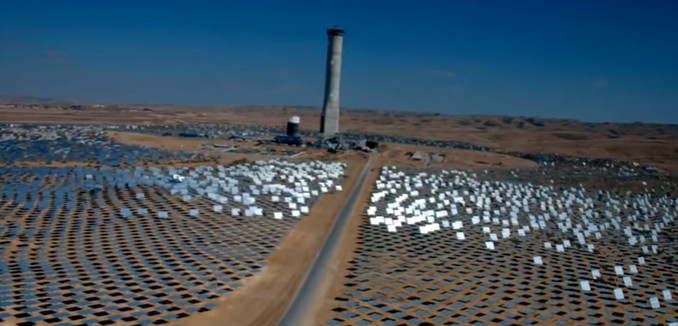The world’s tallest solar tower is currently being constructed in Israel’s Negev desert, the latest example of the Jewish state’s newfound emphasis on renewable energy.
The tower, which will be 250 meters (820 feet) tall, is encircled by around 50,000 mirrors, called heliostats. Unlike the more common photovoltaic solar panels, which convert sunlight directly into power, the heliostats reflect the sunlight into the tower to heat a boiler, which will produce the steam to spin a turbine to generate electricity. With a taller tower, more mirrors can be placed in a smaller area to reflect the necessary amount of sunlight to run the turbine. There are only about a dozen solar tower fields around the world, including one in California with three towers, each of which is 140 meters (460 feet) tall, surrounded by 170,000 heliostats.
The tower is just one of three power plots in Ashalim, with each plot using a different form of solar technology. The second plot will use technology that stores solar energy for use when the sun is not visible, and the third plot will have traditional photovoltaic solar panels. A fourth plot is also planned.
“It’s the most significant single building block in Israel’s commitment to CO2 reduction and renewable energy,” Eran Gartner, chief executive of Megalim Solar Power Ltd., which is building part of the solar project, told the Associated Press. The country’s goal is to have 10 percent of its energy generated from renewable sources by 2020, up from the current 2.5 percent. It is expected that the solar project at Ashalim will generate a comparable amount of electricity to established large-scale solar fields in California and Chile. Israel’s Electricity Authority says that the three plots are projected to generate 310 megawatts of power, which would be enough for 130,000 households—around five percent of Israel’s population.
“Israel has a potential to be a sunshine superpower” because of its technological expertise and yearlong sunshine in the desert, Leehee Goldenberg, the director of the department of economy and environment for the Israel Union for Environmental Defense, told the AP.
However, Goldenberg asserted, “Israel’s government hasn’t really been pushing to reach its small goals regarding solar energy.” But Israel’s Finance Ministry said that the cost of generating solar energy has been decreasing, and so if the Ashalim field is successful, it could spur similar projects elsewhere.
In 2014, The Tower profiled Yosef Abramowitz, the CEO of the Israeli solar power company Energiya Global. Abramowitz told reporter Assaf Dudai that his passion for solar energy was inspired by David Ben-Gurion, Israel’s first prime minister.
The sun at Ketura is indeed unbelievable. First, it hangs alarmingly low in the sky. You can almost feel it brushing against your shoulder when you walk through the kibbutz. And it does not gently pat your shoulder like it does in Florida or Venice Beach. It comes in all its fury. It pushes hard, leaning its full weight on you. After a while, you feel like your posture is less upright than usual. Its light also seems stronger. It is tremendously white and blinding, generating a dense wall of heat. When the photographer, Aviram Valdman, and I came to visit the Ketura Sun solar field, we were immediately handed individual bottles of water. You don’t walk around Ketura without water, we were told. You get dehydrated pretty quickly.
So how come nobody else has ever thought of harnessing solar energy in Israel, even though a third of its territory is a sprawling, sun-drenched desert? “Actually,” Abramowitz smiles, “somebody did. His name was [David] Ben-Gurion.” Indeed, here is a startling 1956 quote from Israel’s first prime minister:
The largest and most impressive source of energy in our world and the source of life for every plant and animal, yet a source so little used by mankind is the sun… solar energy will continue to flow toward us almost indefinitely.
Ben-Gurion initiated the nationwide use of solar power for water heaters, making Israel the first country in the world to use solar power for this purpose.
As almost everyone knows, Ben-Gurion also had a thing for the desert. He loved it, and had a grand vision for developing the Arava. Maybe it was his relentless, stubborn nature. Seeing an obstacle before his young state, he just had to overcome it. If the state could conquer the desert, he thought, it could achieve anything.
Abramowitz is eager to take up where Ben-Gurion left off. “We always believed that if there are benefits for the residents of the Arava, the desert will finally bloom,” he says, “so all of Arava Power’s efforts are directed at the Arava.” By the end of 2015, Arava Power’s eight solar fields will provide the entire electric supply for Eilat, Israel’s southernmost city. That’s a remarkable achievement by global standards, but the road to it was mighty dusty. “We had a hundred battles to win,” Abramowitz recalls.
[Photo: ספוט אשלים ב’ / YouTube ]




